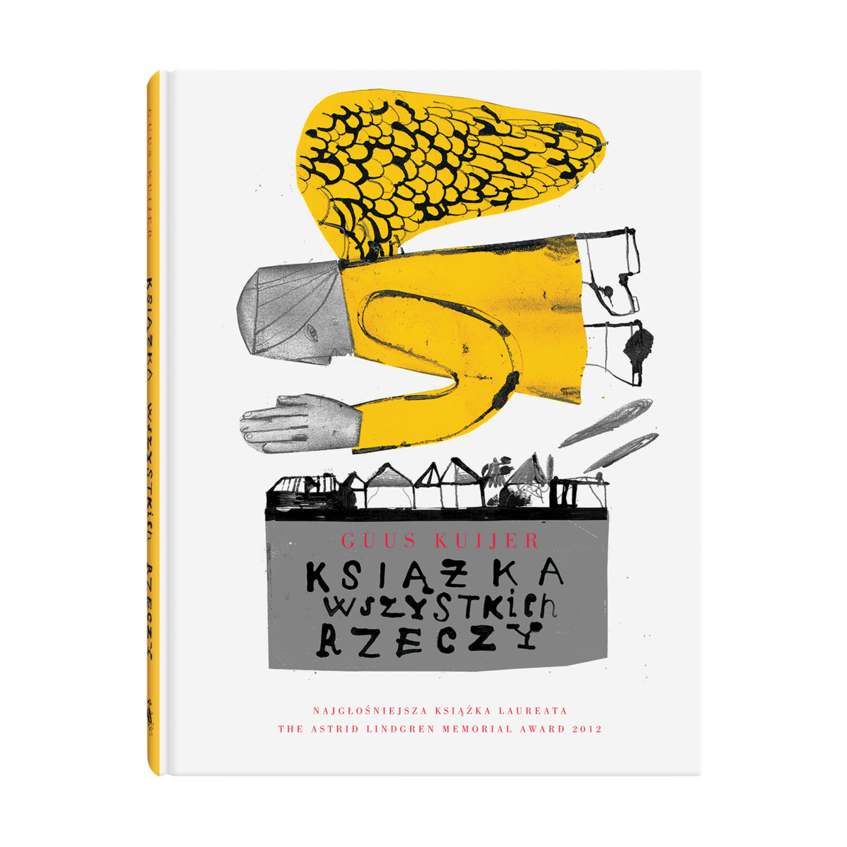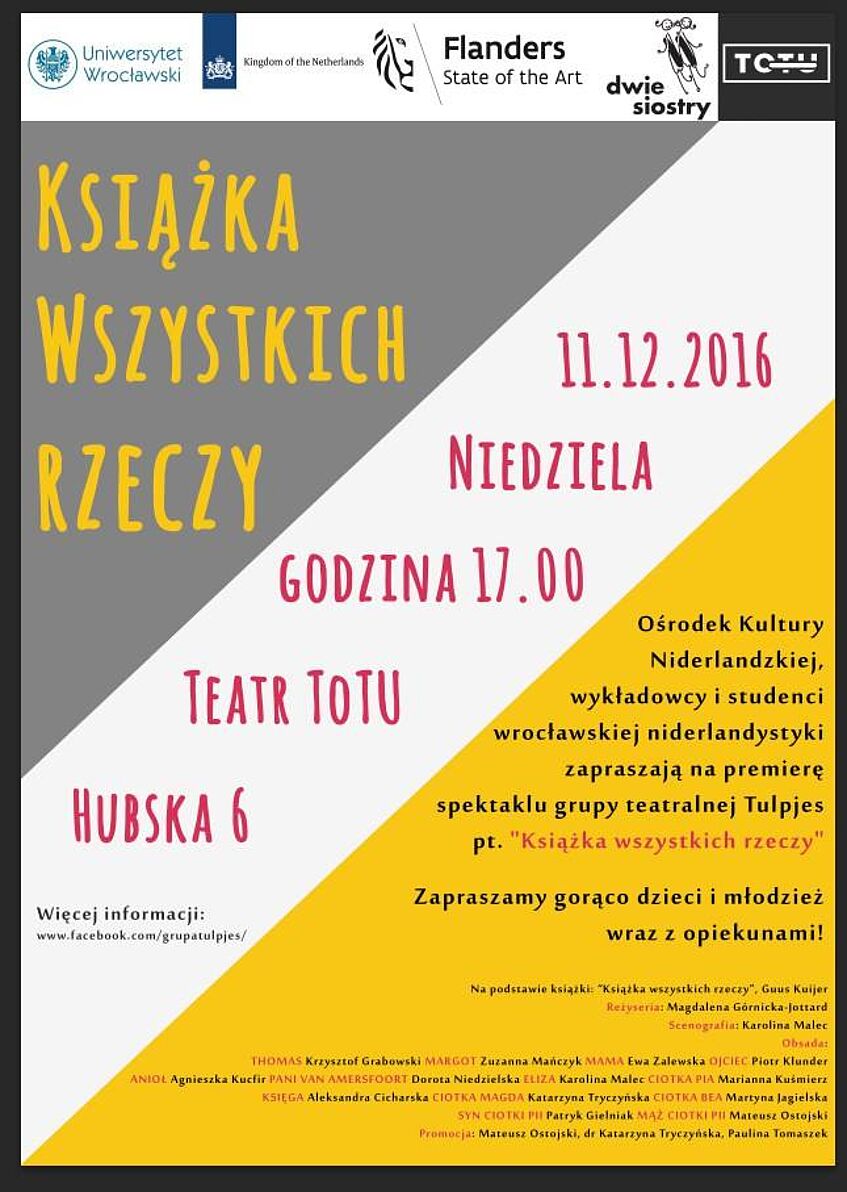The Polish reception of Het boek van alle dingen by Guus Kuijer

Children's literature is often associated with cheerful fairy tales about adventures of fearless pirates or romantic tales of princesses. Nowadays, however, there is a growing number of books in which young readers can learn about the problems of contemporary society. These are the topics that the Dutch writer Guus Kuijer deals with in his works.
Although the taboo on "difficult" topics in Dutch children's literature was lifted in the 1970s, such "difficult topics" in children's and youth books are still considered problematic in Poland. Thus, it is worth looking into how Polish readers receive Książka wszystkich rzeczy (Het boek van alle dingen), as the only Kuijer’s book that has been translated into Polish.
Taboos
Het boek van alle dingen by Guus Kuijer portrays traumatic childhood. This image is made up of all kinds of universal social problems that are often considered taboo in Poland, especially if they appear in children's and youth literature. It deals with issues of Nazis, disability, domestic violence, and religion. Although topics such as Holocaust and disability are present in some Polish children's books, there are relatively few about difficult childhood. Moreover, there are no online accessible articles or other scientific sources related to domestic violence in Polish children's literature. Searching internet browsers for such exemplary titles, translations of foreign works are much likely to come up, by, for example, Gro Dahle or Sarah Crossan. Dom nie z tej ziemi (2017) by Małgorzata Strękowska-Zaremba is one of the very few examples of Polish children’s books on this subject.
This narrow number of children’s books on violence may be one of the factors that influence the reception of Książka wszystkich rzeczy (Polish translation of Het boek van alle dingen). Contrary, there are many books for children and adolescents about religion written by Polish writers. It is since, according to GUS (Statistics Poland), 88.9% of Poles adhere to a particular religion, of which 99.8% are Christian (the statistics come from one year before the publication of the Polish translation of the book). However, finding an example of a Polish children's or youth book in which Christianity is not represented positively is far more challenging. In addition, there aren’t any online accessible articles or any other kind of scientific sources examining a negative image of Christianity in Polish children’s literature. This can be yet another cause that influences the reception of the examined book, which depicts domestic violence in a Christian family.
Translation and adaptations
Het boek van alle dingen was published in 2004. It was subsequently awarded a prestigious literature prize, Gouden Griffel (2005). One year later the book was translated into English, German, Korean and Spanish. The English one (in the United States) and the Spanish one have received a grant from the Literair Productiefonds. The database on the website of Nederlands Letterenfonds (the Dutch Foundation for Literature) shows that this book has been translated into 23 languages in total. The latest translation is from last year (2021); then it was translated into the Eastern Indo-Aryan language Odia. Although the Polish translation appeared almost a decade earlier than the one mentioned above, it still appeared fairly late. The book was translated by Jadwiga Jędryas and published by the publishing house Dwie Siostry with a subsidy from the Nederlands Letterenfonds 8 years after the publication of the original. A possible reason for this might be the ALMA prize awarded to Kuijer the same year. This also confirms the bold announcement on the publisher's website. Namely, it reads as follows:
The most renowned book by the winner of the Astrid Lindgren Memorial Award - the most prestigious award in the field of children's literature (...)
This book was also awarded in Poland. It received Serca “Gagi” prize for the best book in 2013, Mały Dong 2012 (the Polish IBBY prize), and a prize from the printing house Ozgraf in 2012. In 2013, the book was nominated for the prize in the competition Dobre Strony at the children's book fair in Wrocław. All those awards and nominations are listed on the website of the publisher Dwie Siostry. This publishing house plays a major role in the distribution of Dutch children's and youth literature. This is partly thanks to Jędryas, who has not only translated Het boek van alle dingen but is also a co-founder of Dwie Siostry. As a publisher and translator of Dutch, French, and English literature, she, therefore, has an essential influence on the reception of literature.

Poster by Paulina Tomaszek for the theater adaptation by Górnicka-Jottard in the Centre for Dutch Culture at the University of Wrocław
In this manner, Jędryas has introduced Kuijer's work to the Polish reading market. Thanks to her translation, the Polish reception of this book began through the written word. Magdalena Miklasz and Magdalena Górnicka-Jottard have revived this book and enabled its reception through spoken word. In Lower Silesia, there were two performances. In the theater, in Wałbrzych a performance under the title “Tutaj jest wszystko” [Everything is here] was put on. It was directed by Miklasz in collaboration with Amadeusz Nosal, who was responsible for the adaptation of the text and video. A review of the performance can also be found on the website of the theater in Wałbrzych. Although the author of the review has reservations about the stylistic coherence of the performance, he praised Jędryas' translation skills and Kuijer's writing skills. In addition, the publishing house Dwie Siostry was involved as a partner of the show and has thus again influenced the reception of Książka wszystkich rzeczy.
The second performance which also took place in 2016 was the second adaptation of Książka wszystkich rzeczy. It was performed in the ToTu theater under the direction of Górnicka-Jottard by students of Dutch from the University of Wrocław. Its production was made possible thanks to a grant from the Embassy of the Kingdom of the Netherlands and the Delegation of Flanders in the Netherlands, as the goal of this performance was to popularize Dutch-language literature.
Reviews, opinions, and comments
Lastly, to examine the reception of Książka wszystkich rzeczy, in total 53 reviews, opinions, and comments have been collected. They all come from internet forums, blogs of (semi-) professional reviewers, and comments on online bookstores. When it comes to semi- and professional reviews, there are seven of them: six positive and one negative. One of these positive comes from the Internet site on literature Granice.pl. Here the focus is mainly on the author's writing style. The reviewer praises Kuijer for his storytelling method, as well as the author of a review on the blog Poza Rozkładem. According to the two authors, this book is characterized by elegance and unpretentiousness. Some claim that the style of the book adds lightness to the difficult topics. This is noticed by Fijał, who finds the mix of poetic language and humor with the dramatic events a factor that makes this story suitable for nine-year-old children. Elson also sheds light on this, whose review of Książka wszystkich rzeczy has won the first prize in the competition “Wszystkie książki mówią”. According to this reviewer, such humorous elements deprive the book of a sad tone.
What all those reviews mentioned above have in common is the focus on luck as the main theme of this book. This matter is not addressed at all in the last semi-professional review which is the only negative one. This reviewer under the pseudonym 'naczynie gliniane' focuses mainly on the image of faith in the book. According to her, the image of faith and God is wrong and inaccurate, because it is based on the author’s superstitions, stereotypes, and prejudices. In general, the reviewer hesitates whether this book is suitable for children. Not only because of the creation of Christianity presented in it, but also because of the literal and direct descriptions of the violence. Especially when it comes to children who have never faced such a problem.
Whether Książka wszystkich rzeczy is suitable for children and youth is the question that comes up often in the shorter reviews and comments. According to the collected opinions, it appears that five people find this book unsuitable for young readers while eight people would recommend this book for them. Those who would not, declare that this book is too sad and the subject matter it deals with is too mature. In addition, some feel that it can have a bad influence on the child. On the other hand, seven people would hand this book to their child, but, according to them, this book still requires some sort of explanatory comment from the parents. In addition, eleven internet users commented that this book should also be read by adults, for example, to better understand the child's point of view or to discover the underlying message (which the child is not yet able to notice).
(Aleksandra Markiewicz)
References
Fijał, D. (2015, September 13). “Książka wszystkich rzeczy” – Guus Kuijer. https://dofi.com.pl/ksiazka-wszystkich-rzeczy-guus-kuijer/
Galiczek-Kempa, M. (n.d.). Recenzja książki: Książka wszystkich rzeczy. https://www.granice.pl/recenzja/ksiazka-wszystkich-rzeczy/6446
Główny Urząd Statystyczny. (2019). Wyznania religijne w Polsce w latach 2015–2018. Zakład Wydawnictw Statystycznych.
[GryzakVanDoll]. (2019, July 28). Myślę, że swobodnie można porównać tą książkę do "Małego Księcia" - z pozoru zwykła książka dla dzieci, jednak po. lubimyczytac.pl/ksiazka/161410/ksiazka-wszystkich-rzeczy
[Iga]. (2015, October 20). Ta książka z pewnością nie zostałaby nagrodzona,gdyby nie wpisywała się w obecne trendy przeciw rodzinie i wierze /oczywiście opartej. https://dofi.com.pl/ksiazka-wszystkich-rzeczy-guus-kuijer/
[Kawazliterami]. (2014, February 16). Ciekawa, ale jak na książkę dla dzieci – smutna [Online forum post]. lubimyczytac.pl/ksiazka/161410/ksiazka-wszystkich-rzeczy
Kuijer, G. (2004). Het boek van alle dingen. Querido.
Kuijer, G. (2012). Książka wszystkich rzeczy. Wydawnictwo Dwie Siostry.
Mazurkiewicz, H. (2016, September 26). Zaufaj Teatrowi. https://teatr.walbrzych.pl/dzialalnosc-czyli-spektakle/spektakle-dormanowskie/tutaj-jest-wszystko/recenzje/zaufaj-teatrowi/
Naczynie Gliniane. (2013, January 21). Guus Kuijer “Książka wszystkich rzeczy”. https://czytanki-przytulanki.blogspot.com/2013/01/gus-kuijer-ksiazka-wszystkich-rzeczy.html
Nederlands Letterenfonds. (n.d.). Vertalingen database. Letterenfonds. https://letterenfonds.secure.force.com/vertalingendatabase/zoeken
Ośrodek Kultury Niderlandzkiej. (n.d.). Spektakl “Książka wszystkich rzeczy”. Katedra Filologii Niderlandzkiej. http://www.kfn.uni.wroc.pl/AKTUALIA/2016/Teatr_OKN/zaproszenie2_aktualia.htm
Poza Rozkładem (2013, January 20). Książka wszystkich rzeczy. http://pozarozkladem.blogspot.com/2013/01/ksiazka-wszystkich-rzeczy.html
Teatr w Wałbrzychu. (n.d.). Tutaj jest wszystko. https://teatr.walbrzych.pl/dzialalnosc-czyli-spektakle/spektakle-dormanowskie/tutaj-jest-wszystko/
[Tomasi_Ptah] (2021, April 3). Książka dla dzieci jak zwykle sprawnie wywołująca emocje, natomiast poruszona tematyka jest jak dla mnie zbyt dorosła i aż nadto. https://lubimyczytac.pl/ksiazka/161410/ksiazka-wszystkich-rzeczy
Wesoła, B. P. (2014, May 23). Książka wszystkich rzeczy – recenzja Matyldy Elson. Blog Biblioteki Publicznej w Dz. Wesoła m. st. Warszawy. http://biblioteka-w-wesolej.blogspot.com/2014/05/ksiazka-wszystkich-rzeczy-recenzja.html
Wydawnictwo Dwie Siostry. (n.d.). Guus Kuijer. wydawnictwodwiesiostry.pl/katalog/autorzy/guus-kuijer
